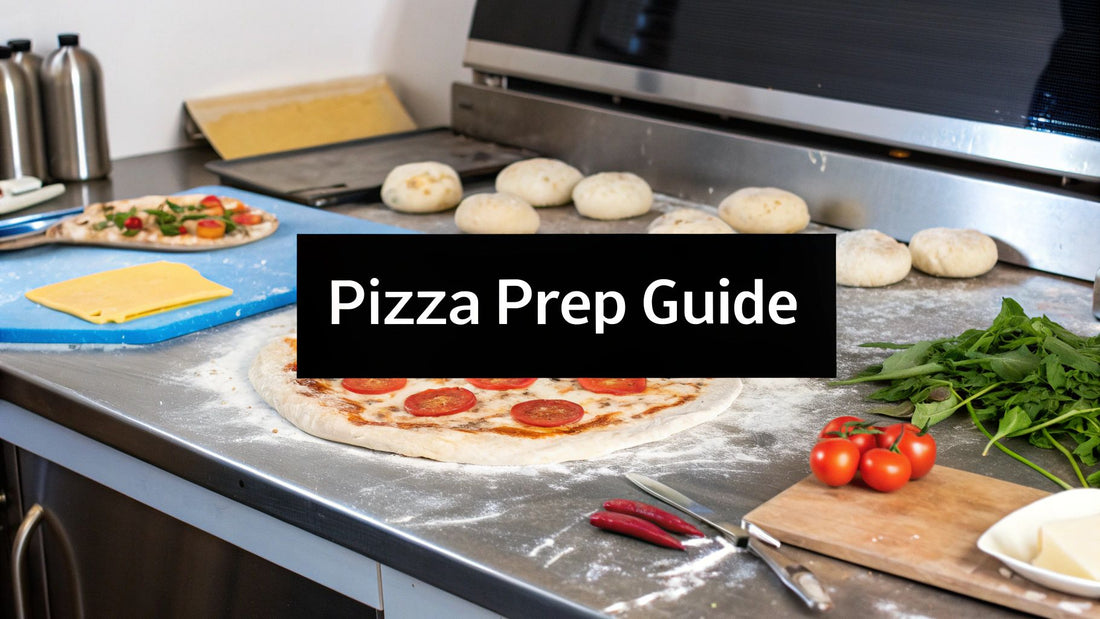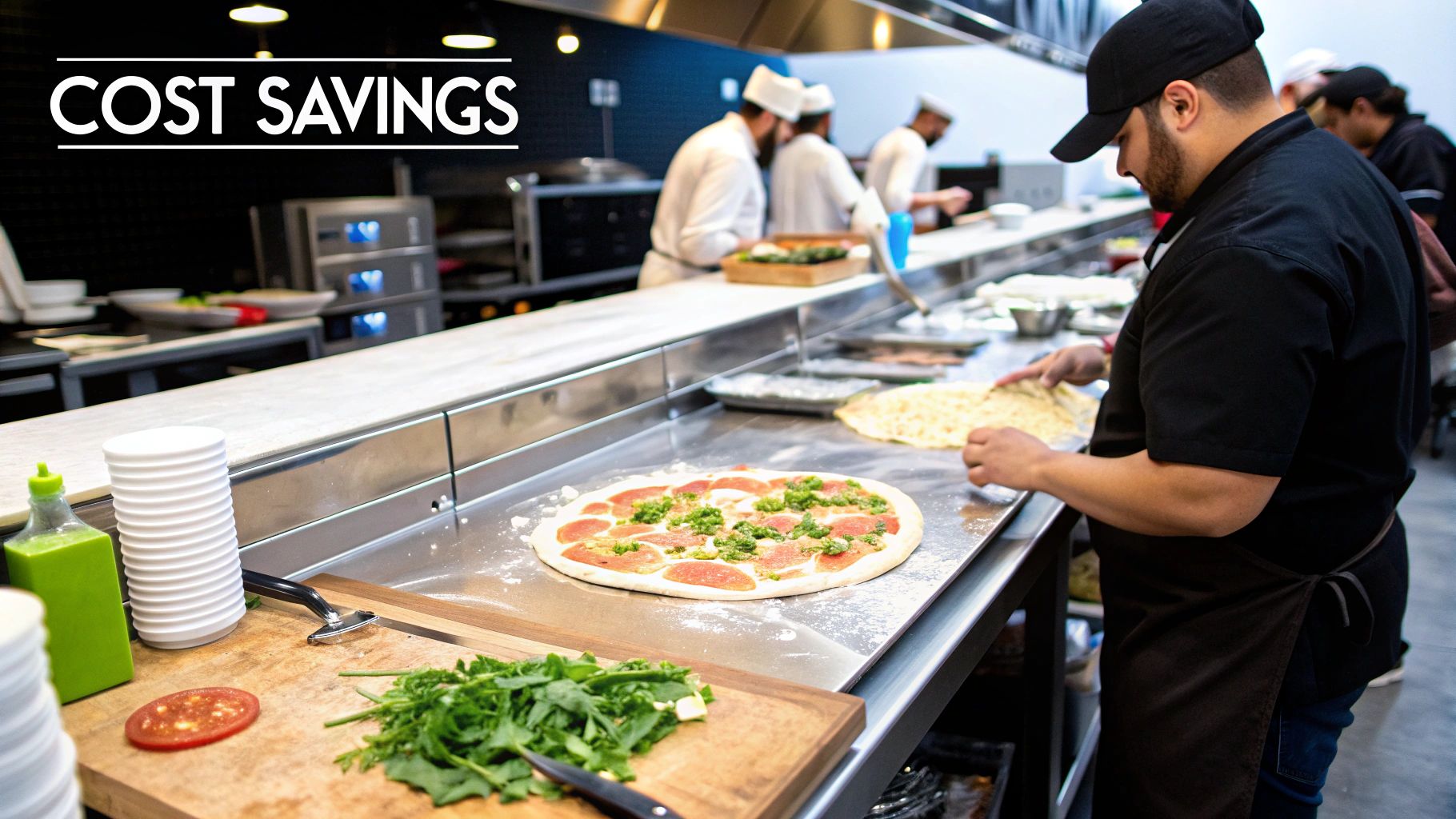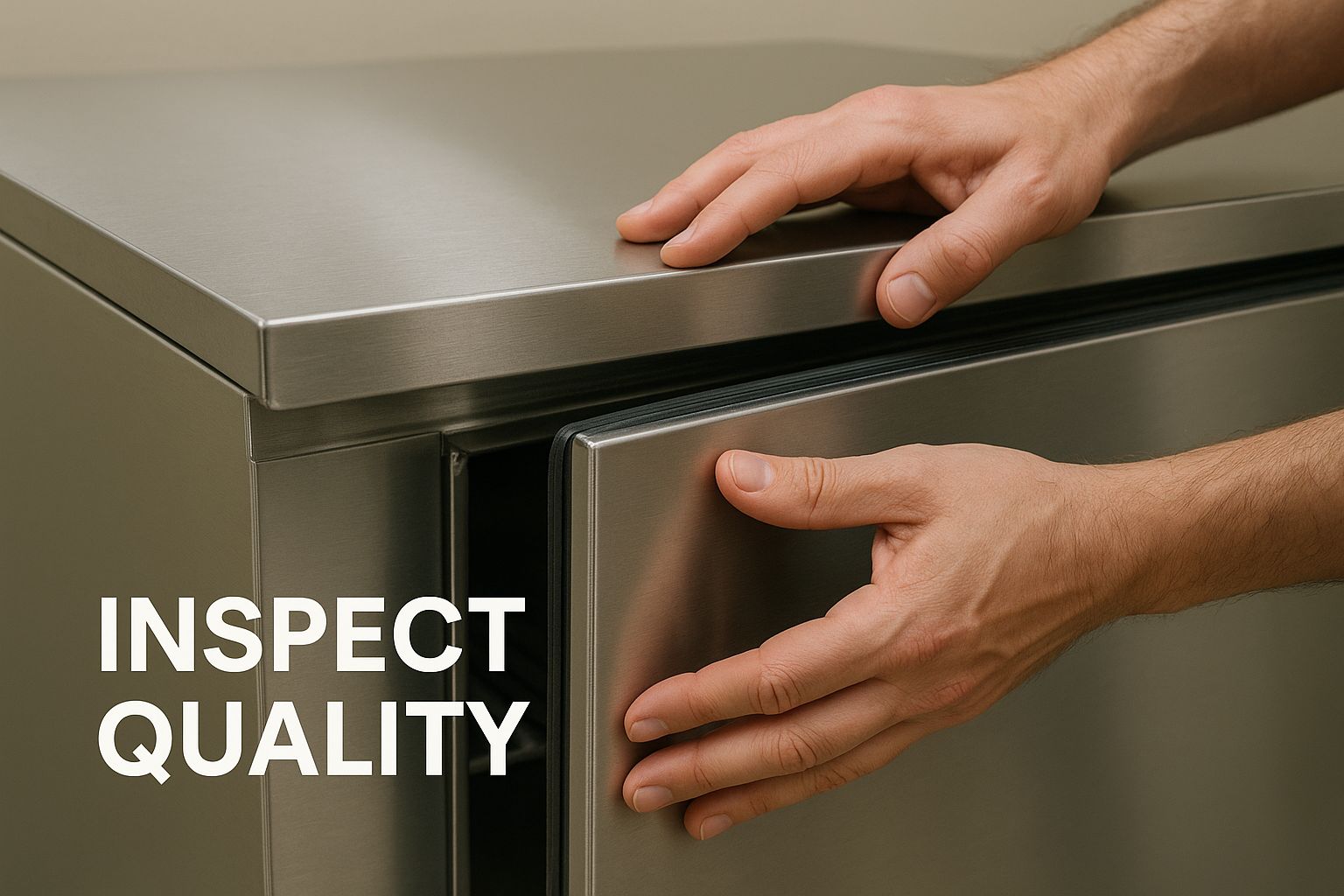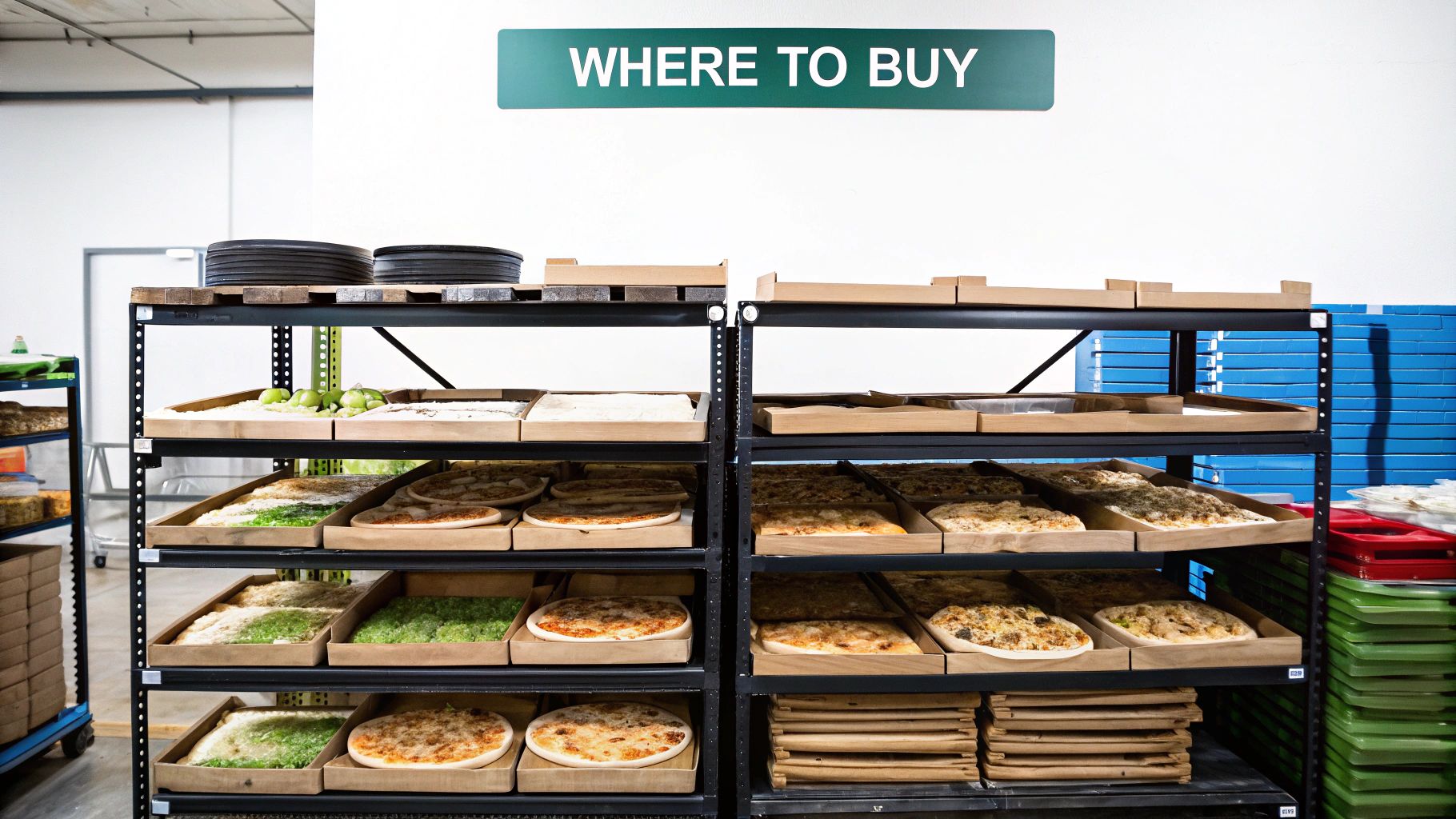
A Smart Buyer's Guide to Used Pizza Prep Tables
Share
Going with a used pizza prep table is one of the smartest moves you can make when opening or expanding your pizzeria. It’s a strategic choice that frees up a huge chunk of your startup capital, letting you put that money toward things that directly impact your customers, like marketing or high-quality ingredients for your signature pies.
The Smart Money Behind Used Pizza Prep Tables

Let's be real—brand-new commercial kitchen equipment comes with a staggering price tag. But experienced pizzeria owners know that buying used isn’t about being cheap; it’s about being strategic. This approach can get you a bigger, more efficient unit from a top-tier brand that would have been completely out of reach if you were buying new.
This one decision can have a ripple effect across your entire pizzeria's output. A larger prep surface or more refrigerated ingredient wells can dramatically cut down ticket times during that chaotic dinner rush. That means happier customers, better reviews, and a healthier bottom line.
Gaining a Competitive Edge
Picture this scenario, one I’ve seen play out dozens of times: a small, independent pizzeria is just getting off the ground with a tight budget. Instead of settling for a tiny, brand-new prep table their team will outgrow in six months, they find a well-maintained, used 72-inch unit from a reputable brand for the exact same price.
This instantly gives them:
- Increased Capacity: Now two pizzaiolos can work side-by-side without bumping elbows, building pies faster.
- Better Workflow: They're spending less time running back to the walk-in to restock toppings and dough.
- Future-Proofing: The table is ready to handle higher volume as the business inevitably grows.
This isn't just about the money you save on day one. It's about investing in operational efficiency from the get-go, which gives you a real, tangible advantage over the competition. And the demand for this kind of equipment isn't slowing down. In fact, the global market for pizza prep tables was valued at USD 4.1 billion by 2025, with steady growth projected through 2032.
Choosing a used pizza prep table is less about the initial savings and more about the long-term value it brings to your kitchen's workflow and your pizzeria's profitability.
As you start browsing, remember to think about the total cost of ownership. Don't forget to look into ways to reduce shipping costs, as freight can significantly bump up the final price on a heavy piece of equipment. The pizzeria owners I know who've scored the best deals all say the same thing: doing your homework upfront is what leads to the biggest wins.
Map Out Your Kitchen for the Perfect Prep Table
Before you even think about browsing online listings or walking into a showroom, the most important work happens right inside your own pizzeria. Trust me, jumping into the market for used pizza prep tables without a rock-solid plan is a surefire way to make a costly mistake. Think of this first step as creating a blueprint; it guarantees the table you bring home fits your space, your workflow, and your pizza-making process.
First things first, grab a tape measure. You absolutely need to know the maximum length, width, and height your space can handle. But don't stop there. You have to account for clearance on all sides, especially the back. Refrigeration units need at least 3-4 inches of breathing room for proper airflow. Skimp on this, and you'll starve the compressor, causing it to overheat and fail way sooner than it should.
Now, think about your pizzaiolos. During a chaotic Friday night rush, will your team have enough space to move around the table without bumping into each other? Walk the path. Imagine carrying hot pizza pans or pushing a dough cart. A new table shouldn't create a bottleneck; it should make things flow smoother. Getting these details ironed out is fundamental, and you can learn a lot more by looking into smart commercial kitchen layout design.
Calculate Your Capacity and Configuration
With your dimensions locked in, the next big question is about volume. How many pizzas are you slinging during your busiest hour? This number directly impacts the size of the refrigerated rail you'll need. A small cafe serving flatbreads might be fine with a table that holds eight 1/6-size pans. But a high-volume pizzeria? You'll need a beast that can hold twelve or more 1/3-size pans just to keep up with topping demand.
Don't forget about what's happening underneath. The undercounter storage is just as critical. Do you need refrigerated drawers for quick, organized access to your portioned dough balls? Or would simple swing doors with shelves for bulk cheese and sauce buckets be more practical for your operation?
- Refrigerated Drawers: Fantastic for keeping pre-portioned items like dough and cheese organized and ready to grab. They enforce tidiness but usually offer less bulk storage space.
- Cabinet-Style Doors: These are your go-to for storing larger, bulkier items like cases of sauce or extra dough trays. You get more flexible space, but it can turn into a disorganized mess without some serious management.
As you plan, it's smart to see how this one piece of equipment fits into the bigger picture. Looking at a comprehensive equipment list for a new food business can help you visualize how your prep table will work alongside your pizza ovens, mixers, and everything else in your kitchen puzzle.
Nail Down the Material and Electrical Details
The cutting board is where the magic happens, so the material is a huge deal. Most used tables you'll find come with a polyethylene board. It's a solid choice for a pizza operation—durable, easy to sanitize, and won't dull your pizza cutters too quickly. While a beautiful marble surface is a dream for working with dough because it stays naturally cool, they're much rarer on standard prep tables and can be a pricey headache to replace if they get chipped or cracked.
Finally, and I can't stress this enough, check your electrical setup. A prep table is just a big, expensive paperweight if you can't plug it in. Confirm the voltage and phase requirements of any unit you're considering and make sure it matches your kitchen's outlets. A mismatch can lead to hiring an expensive electrician for rewiring or, even worse, frying the compressor the moment you turn it on.
How to Find Quality Used Pizza Prep Tables
Finding a great used pizza prep table is part treasure hunt, part detective work. It’s no secret how vital these tables are—the market was valued at a whopping USD 1.75 billion in 2024 and is expected to hit USD 4.92 billion by 2033. That explosive growth tells you everything you need to know about their importance in a modern pizzeria. You can see the market trends for yourself to get a better sense of what's driving the demand.
Your search for the perfect unit will take you down a few different roads, each with its own quirks. Knowing the pros and cons of where you're looking is the key to finding a reliable workhorse for your pizzeria instead of a costly headache.
Exploring Your Sourcing Options
When you start digging around for used equipment, you'll find three main players: certified dealers, online marketplaces, and local auctions. I’ve seen pizzeria operators have success with all three, but your approach has to change for each one.
A certified used equipment dealer is usually your safest bet. These guys inspect, clean, and sometimes even refurbish the tables they sell. The real kicker? Many will offer a limited warranty—usually 30 to 90 days—which is huge when you're buying used. That little piece of paper can save you from a disaster.
Then you have the Wild West: online marketplaces. Places like Facebook Marketplace or restaurant forums can be a goldmine for pizzeria equipment, but they’re also the riskiest. These are almost always "as-is" sales. If the compressor gives up the ghost a week after you get it home, that’s your problem. Restaurant auctions are the middle ground, offering incredible deals if you have a sharp eye and can make decisions on the fly.
This image really drives home the most important rule, no matter where you're buying.

Seriously, a hands-on check is non-negotiable. Tiny details like a worn-out door seal might not seem like a big deal, but they often point to bigger, more expensive problems with the entire refrigeration system.
Comparing Your Sourcing Options
To make sense of it all, it helps to see the options laid out side-by-side. Each channel has its moments to shine, but also its potential pitfalls for a pizza business.
| Sourcing Channel | Pros | Cons | Best For |
|---|---|---|---|
| Certified Dealers | Inspected & cleaned units, limited warranty (30-90 days), higher reliability. | Higher price point, limited selection based on inventory. | First-time buyers or pizzeria owners who value peace of mind over the lowest price. |
| Online Marketplaces | Potential for incredible bargains, wide selection, direct negotiation. | High risk, "as-is" sales with no warranty, scams are common. | Experienced operators who know exactly what to look for and can afford the risk. |
| Restaurant Auctions | Great deals on equipment from recently closed pizzerias, quick process. | Fast-paced environment, limited inspection time, all sales are final. | Pizzeria owners who can inspect equipment quickly and are comfortable with competitive bidding. |
Ultimately, your comfort level with risk and your own expertise will determine the best path. There's no single "right" answer, just the right answer for your specific pizzeria.
Tips for Each Channel
You can’t approach a dealer the same way you’d approach a private seller on Craigslist. You need a game plan tailored to each source.
Here’s my advice from years of seeing this play out:
- Certified Dealers: Always ask for the unit’s history. Where did it come from? Was it from another pizzeria? Most importantly, get a list of any repairs or refurbishments they performed.
- Online Marketplaces: Don't just rely on photos. Ask the seller for a video of the unit running. Have them stick a thermometer inside the refrigerated section to prove it actually gets—and stays—cold.
- Restaurant Auctions: Show up early. You need time to inspect the equipment before the chaos of bidding begins. Plug it in and listen. Does the compressor sound like it’s struggling? Any weird rattles or hums are a major red flag.
Here's a pro tip that gets overlooked: talk to other local pizzeria owners. Networking is one of the most powerful sourcing tools you have. Fellow restaurateurs can give you the real scoop on local dealers or even let you know when they're about to upgrade their own gear, giving you first dibs on a machine they've taken care of.
Alright, you've tracked down a promising used pizza prep table. Now for the moment of truth: the in-person inspection. This is where you separate the hidden gems from the money pits, moving beyond shiny online photos and a seller's best-case-scenario description.
Show up prepared. A good flashlight and your own thermometer are non-negotiable. Think of yourself as a detective looking for clues about the unit's past life and its future reliability for your pizza shop. This isn't just about kicking the tires; it's a methodical check that can save you a fortune in repair bills down the line.
Your In-Person Inspection Checklist
Let’s get hands-on and figure out what you’re really looking at.
Start with the Heart of the Machine
The refrigeration system is the single most expensive and critical part of a used pizza prep table. If it’s on its last legs, you’re not buying an asset—you’re buying a very heavy, stainless steel paperweight. Always start your inspection here.
-
Plug It In and Listen. First things first, get it running. A healthy compressor should kick on with a smooth, steady hum. If you hear any loud clanking, rattling, or feel a ton of vibration, that’s a major red flag. Those are the tell-tale sounds of a compressor that's about to punch out.
-
Feel the Airflow. Carefully put your hand near the condenser coils, which are usually at the back or side of the unit. You should feel warm air being pushed out by the fan. No airflow, or cool air, could mean a dead fan or a much bigger problem with the cooling cycle.
-
Check the Coils. Get your flashlight out and take a hard look at the condenser coils. A bit of dust is normal and easy to clean. What you’re looking for is thick, greasy gunk or heavy corrosion. Corroded coils are terrible at getting rid of heat, which makes the compressor work overtime until it burns out.
Your ears and hands are your best tools for the initial refrigeration check. A struggling compressor doesn't hide its problems well—it will almost always sound or feel wrong long before it completely gives out.
Examine the Structure and Seals
Once you've given the cooling system a thumbs-up, shift your focus to the table's body. A few dings and scratches on the stainless steel are fine—it’s used equipment, after all. You’re hunting for issues that mess with performance and sanitation in your pizzeria.
The door gaskets are your next big checkpoint. These rubber seals are vital for keeping the cold air in and your electricity bill down. Run your fingers along the entire gasket on each door. They should feel soft and flexible. If they’re brittle, cracked, or have chunks missing, they’re shot and will need to be replaced.
A bad seal makes the compressor run non-stop, which spikes your energy costs and puts a ton of strain on the whole system. Gaskets aren't a deal-breaker, but you need to factor that replacement cost into your offer. If you find yourself needing new ones, it helps to know where to find pizza prep table parts for the specific model you're looking at.
Final Checks and Temperature Verification
Now for the details that affect day-to-day pizza making. Open and close every single door and drawer. Do they swing smoothly? Do they latch securely? A sagging hinge is more than just annoying; it creates air leaks and wastes energy.
Next, give the electrical cord and plug a thorough once-over. Any fraying, exposed wires, or damage is a serious safety hazard.
Finally, test the temperature yourself. Don't just take the seller's word for it. Put your own thermometer inside the main cabinet and the top rail, shut the doors, and let the unit run for at least 15-20 minutes. A food-safe prep table absolutely must hold a temperature of 40°F (4°C) or below. If it can't hit that number and stay there, walk away. This simple test is the ultimate proof of whether you’ve found a bargain or a bust.
The market for this gear is huge—the global food prep tables market was valued at USD 1.18 billion in 2023 and is only getting bigger. That's a lot of pizzerias needing reliable equipment. You can discover more insights about these market trends to see just how valuable a good, working unit really is.
Negotiating a Fair Price for Your Prep Table

You’ve found a promising unit and given it a thorough once-over. Now comes the part that makes most people a little nervous: the negotiation. But this doesn’t have to be some tense showdown. When you do it right, it’s just a respectful business conversation where everyone walks away feeling good.
The key is to come prepared. That inspection checklist you just ran through? It’s not just for dodging lemons—it’s your negotiation toolkit. That worn-out door gasket or the slightly sticky drawer hinge you spotted are fair, objective points to bring up.
Turning Your Inspection Findings Into Leverage
Before you even think about making an offer, do a quick bit of market research. A quick search for the same make and model of similar used pizza prep tables will give you a solid baseline. This ensures your offer is grounded in reality, not just wishful thinking.
When you present your offer, frame it around what you found during the inspection. Instead of just throwing out a number like, "I'll give you $800," try a more reasoned approach.
- "I'm definitely interested, but I noticed the door gaskets are cracked and will need to be replaced right away. Considering that will cost me around $150, would you be willing to accept $850?"
- "The unit is in good shape overall, but the cutting board is heavily scored and is going to need a professional resurfacing. I’d be comfortable at $1,200 to account for that repair."
This approach immediately shows the seller you’ve done your homework and are a serious buyer, not just someone trying to lowball them. It turns a subjective haggle into an objective discussion about the table's actual condition and current value.
A fair negotiation isn't about "winning." It's about arriving at a price that accurately reflects the equipment's condition and remaining lifespan for your pizzeria. Your inspection findings are the cold, hard facts that build your case.
Finalizing the Deal and Getting It Home
Once you’ve both agreed on a price, the last few steps are all about protecting your new investment. It is absolutely crucial to get everything in writing, even if it’s just a simple bill of sale. This document should clearly state the final price, the model and serial number, and—most importantly—that the sale is "as-is."
Understanding that "as-is" clause is vital. It means that once you pay up and take possession, any problems that pop up later are your responsibility. This is totally standard for private used equipment sales and is precisely why your pre-purchase inspection is so non-negotiable.
For bigger purchases, some pizzeria owners explore financing to keep their cash flow healthy. You can get a better sense of how that works by reading up on commercial kitchen equipment leasing, which offers another path to getting the gear you need.
Finally, don't skimp on transport. A heavy, awkward prep table can be damaged in a heartbeat if it’s moved improperly. Always opt for an insured freight or professional delivery service. Paying a little extra for movers is a whole lot cheaper than trying to fix a refrigeration line that got busted when the unit was dropped off the back of a pickup truck.
Got Questions About Used Prep Tables? We've Got Answers
Even after you've kicked the tires and settled on a price, it's totally normal to have a few last-minute questions before you pull the trigger. Buying used equipment is a big deal for your pizzeria, and you want to be sure you're making a smart move. Let's tackle some of the most common things pizzeria owners wonder about.
How Long Will a Used Pizza Prep Table Last?
Think of a good commercial prep table like a trustworthy work truck. A well-maintained unit from a solid brand can easily give you 10-15 years of service in a busy pizzeria, no problem.
The real sweet spot for buying used is finding a table that's between three and seven years old. It has already taken its biggest depreciation hit, but it still has a ton of life left in it. That's where you'll find the absolute best value for your money.
Which Brands Should I Look For?
When you're buying a used car, you stick with brands known for reliability, right? The same logic applies directly to used pizza prep tables.
It's always a smart move to focus on the industry workhorses like True, Turbo Air, and Avantco. These brands are built to survive the beautiful chaos of a commercial kitchen. More importantly, when something eventually does need fixing, you can actually find replacement parts and technicians who know how to work on them. An off-brand unit might look like a steal upfront, but it can turn into a massive headache if a simple part fails and you can't find a replacement anywhere.
No matter how great a used unit looks, it's always wise to keep a little cash set aside. Budgeting an extra 15-25% of the purchase price for potential maintenance or unexpected repairs is a smart safety net for any pizzeria.
This contingency fund gives you incredible peace of mind. You'll know you can handle anything from a quick refrigerant recharge to replacing all the door gaskets without derailing your entire budget.
What’s the Deal with Warranties and "As-Is" Sales?
This is probably one of the biggest differences between sellers, and you need to be crystal clear on what you're getting before any money changes hands.
-
Private Sales & Auctions: These are almost always sold "as-is." That means once you pay for it and haul it away, it's 100% your problem. There’s no warranty, period. You're taking on all the risk.
-
Used Equipment Dealers: Reputable dealers, on the other hand, often stand behind the equipment they sell. It's pretty common for them to offer a limited 30 to 90-day warranty on major components, especially the compressor. This short-term protection is incredibly valuable, as it covers the most expensive part that could possibly fail.
Paying a little bit more for a unit that comes with that kind of assurance can be a very, very wise investment for any pizzeria owner.
Ready to find the perfect workhorse for your kitchen? At Pizza Prep Table, we offer a curated selection of high-quality new and used pizza prep tables to fit any budget and space. Explore our collection today!
